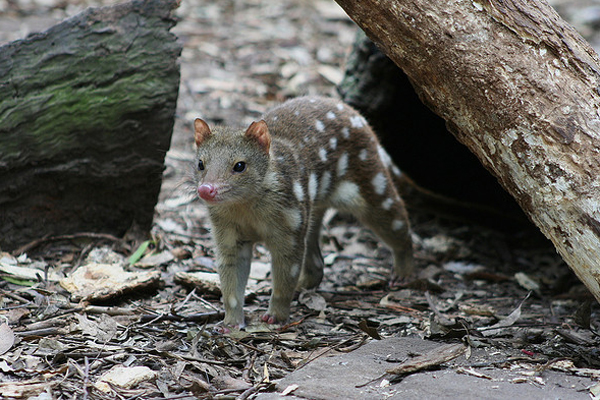June 17, 2014
Tiger quoll alive and well in the Watagan Mountains
An elusive but thriving tiger quoll population has been found near Newcastle by UOW researchers.
The tiger quoll, also known as the spotted-tailed quoll is mainland Australia’s largest marsupial carnivore and a formidable hunter. It is able to climb trees, hunt possums and birds with jaws providing as much power (in relation to its size) as the sabre-tooth tiger.
But since the European settlement the tiger quoll is now threatened with extinction.
A recent remote camera survey of the endangered tiger quolls in the Watagan Mountains in Lake Macquarie City Local Government Area (near Newcastle) has, however, found a small but seemingly thriving population.
A Lake Macquarie environmental research grant was awarded in 2012/2013 to scientists from UOW -- Dr Katarina Mikac, Dr Chris McLean and Angelica Varhammar (two of whom are local residents of the Lake Macquarie area), to use remote, motion activated cameras to survey the local government area in search of the endangered carnivore.
The tiger quoll is a uniquely Australian native, roughly the size of a cat, which is distinctively marked with white spots all over its body. The tiger quoll is a veracious predator that mostly lives in forests along the east coast of Australia. It is listed as nationally endangered by the Commonwealth Government (under the Environment Protection and Biodiversity Conservation Act 1999), meaning that there is a very high chance that the tiger quoll can become extinct in the wild in less than a decade.
Dr Mikac, who is a Master of Science Lecturer in the Faculty of Science, Medicine and Health’s International Office, said the study aims to provide current information on the exact location and numbers of tiger quolls in its local government area, so that it can best manage the population and ensure the native marsupial’s long term survival.
The research is ongoing and the use of remote cameras has proved vital to the success of the project, allowing photos to be taken of the tiger quolls without the physical presence and interference of the scientists. Cameras are baited with raw chicken wings and left for at least two weeks to lure in the hungry predator whose photo is taken, along with the date and time of the sighting.
Camera images to date have found an array of other natives along with introduced and domestic animals. It seems the Watagan Mountains are not just home to tiger quolls, but also many birds, feral dogs and cats as well as inquisitive wallabies and small native marsupials such as bandicoots and potoroos.
Surveys have also occurred closer to urban development in the Lake Macquarie area, however, these sites have not yet detected any tiger quolls. The researchers are still continuing to investigate urban areas and hope soon to detect tiger quolls.
Dr Mikac said the remote cameras are providing a photographic gallery of the animals that live in the Lake Macquarie area and in doing so provide invaluable scientific data that will help manage the endangered tiger quoll and ensure it keeps its top marsupial predator status for a long time to come.
The Lake Macquarie environmental research grant was funded by the City Council with assistance from sponsors (Eraring Energy, Delta Electricity, and Oceanic Coal/Xstrata).
